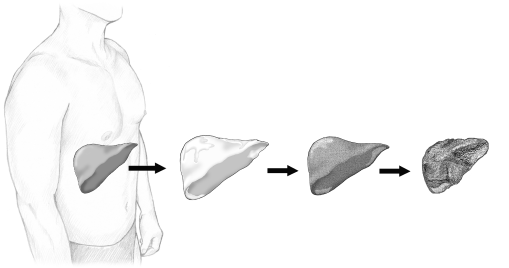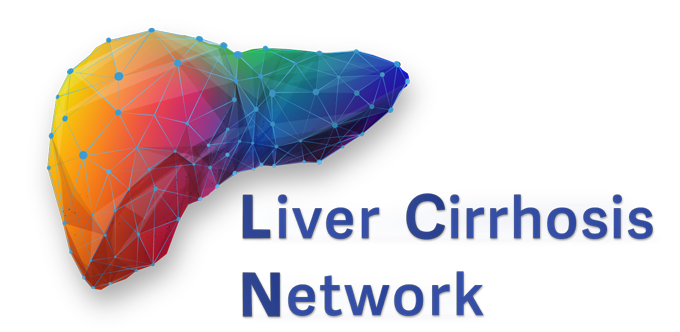For Patients
Helping people
living with
cirrhosis
stay healthy.
cirrhosis Basics
Where is the liver?

The liver is located under the ribs on your right side (figure 1). It is connected to your gut (intestines and stomach) by a blood vessel that is called the portal vein.
What does the liver do?
The body cannot survive without the liver. The liver does many important things:
- Makes things that help the body function properly
- Cleans the blood
- Stores important things for the rest of the body to use as needed
What are the functions of the liver?
Makes things
Bile
Helps digest food
Albumin protein
Many things, including keeping water from leaking out of blood vessels
Clotting proteins
Prevents bleeding after a cut
Anti-clotting proteins
Prevents clots in blood
Hormones (many)
- Helps make platelets (part of blood)
- Keeps blood pressure regular
- Keeps bones and muscle healthy
- Keeps iron level normal for blood making
Cholesterol
Different types of cholesterol affect the heart in different ways, both good and bad. Cholesterol is also needed to build hormones made by other organs.
Glucose
A sugar the powers your body (your liver has to make it if you have not eaten for a few hours)
Cleans blood
Ammonia removal
The body’s digestion or breakdown of protein makes a toxin (ammonia) which is toxic to your brain and muscle
Drug/toxin breakdown
The liver processes many drugs and toxins. It helps remove them from the blood to avoid build up and harm.
Bilirubin removal
Comes from the breakdown of old red blood cells and the liver usually disposes (too much bilirubin happens with the liver is not functioning properly, causing jaundice)
Stores things
Vitamins
Vitamins A, D, E, K, and B12
Minerals
Iron, copper
What is Cirrhosis?

Cirrhosis is scarring in the liver due to liver disease.
Many things can lead to liver disease:
- Viruses – like hepatitis B or C
- Toxins like alcohol or a buildup of liver fat that is associated with diabetes or being overweight
- Liver conditions that are inherited
- Autoimmune conditions where the body’s immune system hurts the liver cells.
Basically, all liver diseases cause inflammation. Inflammation is redness, swelling, pain or heat. It is a protective reaction to injury, disease or irritation. It’s like if you burn your skin and it becomes red (inflamed). When the redness fades, you are left with a scar. In the liver, the same thing happens. Inflamed liver cells get replaced by scar. This is called fibrosis. When fibrosis becomes severe, cirrhosis develops. A liver with cirrhosis is hard, bumpy, and often shrinks.
How common is Cirrhosis?
As many as 1 million Americans have cirrhosis. Cirrhosis is more common in adults ages 45 and over. As many as 1 in 200 people over 45 years old have cirrhosis. Over time, the number of young people with cirrhosis is also rising. Researchers believe the actual numbers may be higher because many people with cirrhosis are not diagnosed
What happens when you have Cirrhosis?
 In the earliest stage of cirrhosis, you may have no symptoms. In fact, a person may live many years with cirrhosis without knowing it. If liver disease is diagnosed early and treated, your liver can remain in silent for many years. But if nothing is done about the cause of cirrhosis the liver’s condition may worsen. For example, if you continue to drink alcohol, or if hepatitis or other causes of cirrhosis are not treated. Liver function can improve if the cause of liver disease is treated, such as stopping alcohol, or treating hepatitis. The liver can regenerate but recovery takes time.
In the earliest stage of cirrhosis, you may have no symptoms. In fact, a person may live many years with cirrhosis without knowing it. If liver disease is diagnosed early and treated, your liver can remain in silent for many years. But if nothing is done about the cause of cirrhosis the liver’s condition may worsen. For example, if you continue to drink alcohol, or if hepatitis or other causes of cirrhosis are not treated. Liver function can improve if the cause of liver disease is treated, such as stopping alcohol, or treating hepatitis. The liver can regenerate but recovery takes time.
What are the symptoms of Cirrhosis?

Cirrhosis can be “silent,” without any symptoms at all. Symptoms of cirrhosis may include things such as:
- Low energy
- Sleep problems
- Falls
- Decreased sexual satisfaction
- Severe itch
- Muscle cramps
- Muscle loss
- Bleeding varices – Internal bleeding from swollen blood vessels in the esophagus
- Ascites (pronounced “a-sigh-tees”) – a buildup of fluid in the belly

Ascites - Encephalopathy (pronounced “en-sef-a-lop-a-thee”) – confusion from the buildup of toxins in the blood
- Jaundice – yellowing of the eyes and skin
- Liver cancer – also called hepatocellular carcinoma
How does Cirrhosis cause symptoms?
Cirrhosis does two things:
- Decreases the liver’s ability to do the things it needs to do.
- Changes the way the blood flows through the body.
This effect on blood flow is very important. All blood flows from your gut to your liver. Blood normally flows through the liver like an open road, but cirrhosis causes a traffic jam for the blood flow. As blood flows more slowly, it causes a buildup of pressure in the portal vein, the connection between the gut and the liver. This is called portal hypertension. The result is a backup of blood that causes many problems:
- It can reroute blood through veins called “varices”. Some varices can be found in the tube that carries food from your mouth to your stomach (the esophagus) or in your stomach itself.
- Causes the spleen to grow big as it fills with blood. The spleen takes on so much blood, it ends up soaking up things like platelets, lowering the amount of platelets that can be found on blood tests. Platelets are small cells in our blood that stop or prevent bleeding.
- If blood is being routed away from the liver, it means that blood is not being cleaned by the liver. This causes toxins to flow freely in the blood.
- By directing blood away from the liver, it causes less blood to go to the heart. This can stress the body, particularly the kidneys.
- Increased pressure in the portal vein also causes fluid from the surface of the liver and intestine to build up in the belly (ascites) (pronounced “a-sigh-tees”) causing the belly to swell.
It is important to know that even in this late stage, if the cause is removed (such as alcohol), the liver can slowly heal. Other times, the only way to cure cirrhosis is to replace the sick liver with a healthy liver – this is called liver transplantation.
What is Hepatocellular Carcinoma (liver cancer)?
 Cirrhosis (and some liver diseases without cirrhosis) can cause Hepatocellular Carcinoma (liver cancer), which is the most common type of cancer that starts in the liver.
Cirrhosis (and some liver diseases without cirrhosis) can cause Hepatocellular Carcinoma (liver cancer), which is the most common type of cancer that starts in the liver.
Liver cancer is increasing, because cirrhosis is becoming more common. Every year, it happens to about 2 in every 100 people with cirrhosis. A “small” liver cancer begins as a mass (tumor) or bump inside the liver and usually grows slowly, but sometimes it can grow very fast. Sometimes there are many tumors throughout the liver instead of just one. A small liver cancer does not cause symptoms.
Why do we screen for Hepatocellular Carcinoma (liver cancer)?
Cirrhosis (and some liver diseases without cirrhosis) can cause Hepatocellular Carcinoma (liver cancer), which is the most common type of cancer that starts in the liver.
How is Hepatocellular Carcinoma (liver cancer) diagnosed?
Most liver cancer are found with ultrasound imaging. Ultrasound imaging uses sound waves to form pictures of the tissues and organs on a computer screen (sonogram). This is the same type of ultrasound used during pregnancies to check on babies. It is very safe, not invasive, and does not use radiation. Ultrasound imaging can only show if there is a mass or not, it cannot tell you if the mass is liver cancer. It is very important to know that not all masses on the liver are cancers. For this reason, if we find a liver mass with ultrasound, our next step is to arrange a CT or MRI scan. Most cancers can be diagnosed based on a good quality CT scan or MRI.
How is Hepatocellular Carcinoma (liver cancer) treated?
Patients with liver cancer are treated by a team of specialists. Treatment depends on how big the cancer is, where it is in the liver, how many there are and if they have spread outside the liver. Treatment will also be based on how sick you are and how sick your liver is. There are different treatments for patients, including surgery, procedures done by a specialist radiologist, medications prescribed by a cancer doctor, or a liver transplant.


